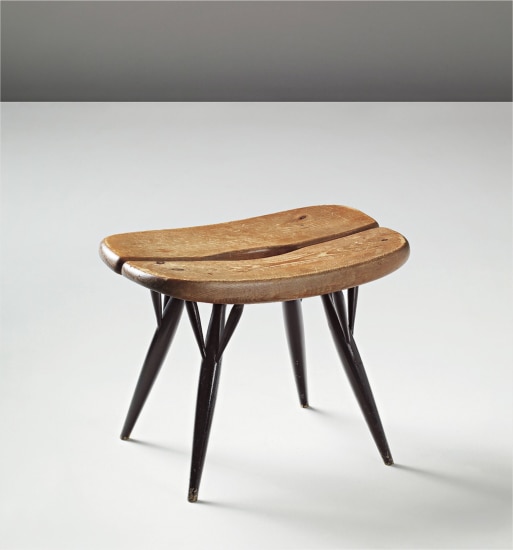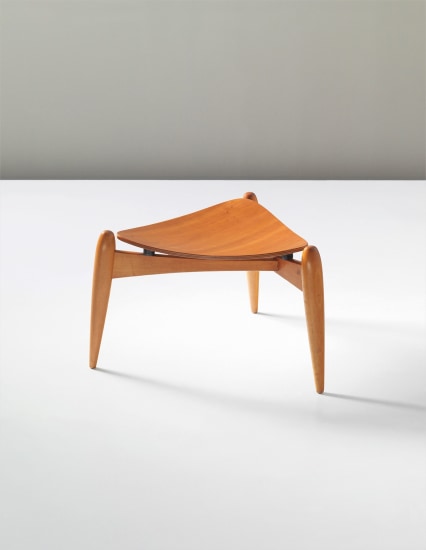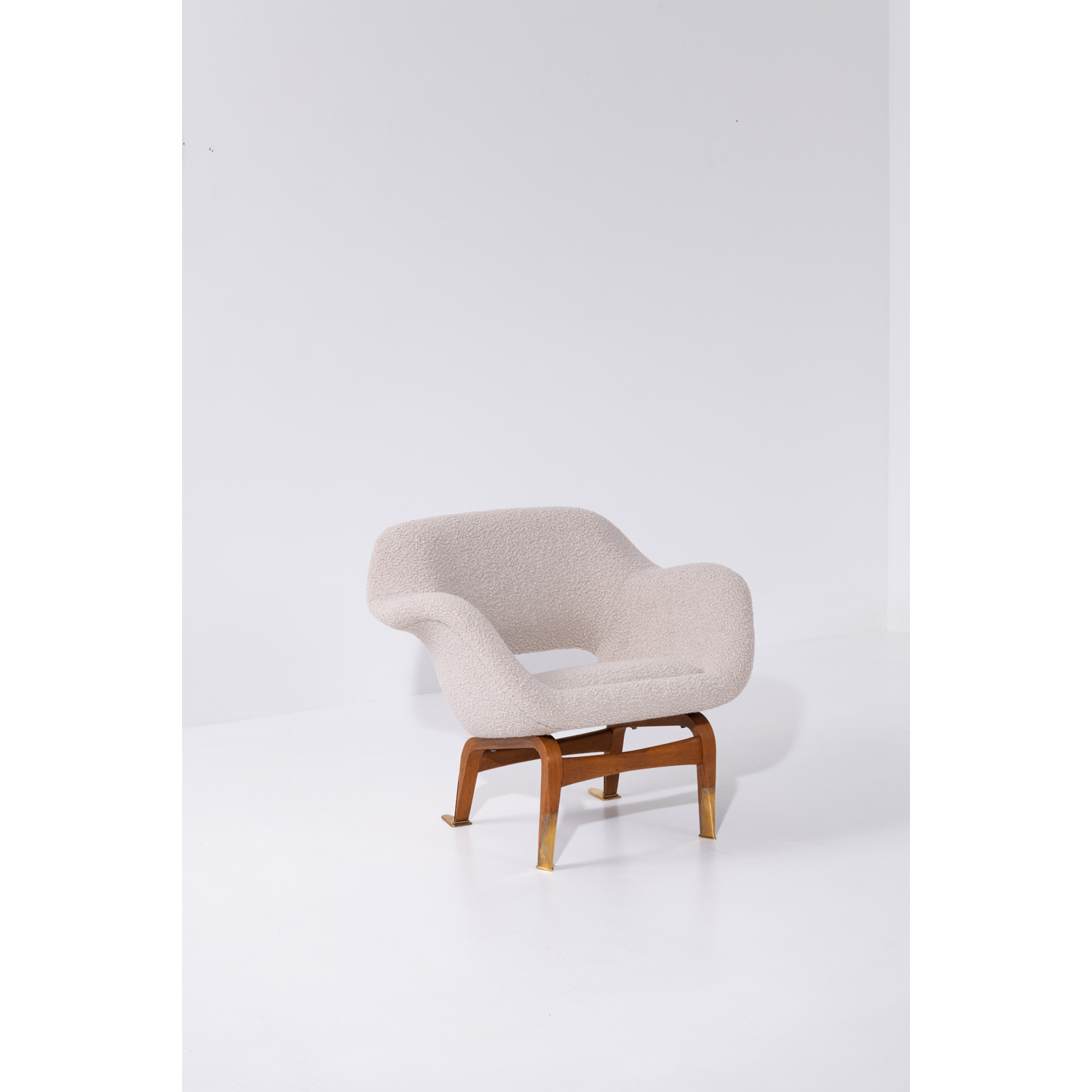Ilmari Tapiovaara Rare ‘Dolphin’ chaise longue c. 1955 Painted oak, laminated oak, leather, painted metal, metal. 84 x 127 x 44.5 cm. (33 x 50 x 17 5/8 in.) Produced by Skanno Ltd., Finland.
Literature Pekka Korvenmaa, Ilmari Tapiovaara, Salamanca, 1997, p. 109, fig. 157 and p. 195, fig. 471 Catalogue Essay During the Continuation War, Finnish designer Ilmari Tapiovaara didn’t raze villages, he built them. Stationed in the Karelian forests along the Soviet frontier (1941-1944), he designed furniture, military housing, canteens, field theatres, and dug-outs for platoon commanders. As a director of the front’s Production Office, he coordinated local forestry and agriculture, as Pekka Korvenmaa has stated in Tapiovaara (Santa & Cole, 1997). His wide-ranging wartime duties, and the practical skills gained, profoundly influenced Tapiovaara’s postwar role as teacher, interiors architect, and furniture maker. As a result, “His attitude is less programmatic, and more pragmatic than his predecessors,” wrote Pilar Cós in the above monograph. “He is primarily concerned for quality over self-promotion.” From Caesar to Napoleon, practicality has been a prerequisite of functional campaign furniture: it must be sturdy and, should the tide turn, portable. No longer under siege, Tapiovaara in the 1950s nonetheless maintained rigorous wartime standards for the realization of his designs; comfort, sturdiness, and lightness characterize all his best work, whether the all-purpose birch and plywood ‘Domus’ chair built for students (1946) or his rare reclining ‘Dolphin’ (Pyöriäinen) chaise, the present lot. The chair has a streamlined, fusiform body, tapering at head and tail. Like its namesake, ‘Dolphin’ is acrobatic; it reclines—and inclines, allowing the feet to rest above the head, thereby promoting improved circulation. What came first, the dolphin or the chaise? Tapiovaara wrote in 1948, “Nature creates faultlessly and economically…,” another lesson learned in the woods. The present lot was produced by Skanno, a family-run furniture and textile firm established in Helsinki in 1946. Read More
Ilmari Tapiovaara Rare ‘Dolphin’ chaise longue c. 1955 Painted oak, laminated oak, leather, painted metal, metal. 84 x 127 x 44.5 cm. (33 x 50 x 17 5/8 in.) Produced by Skanno Ltd., Finland.
Literature Pekka Korvenmaa, Ilmari Tapiovaara, Salamanca, 1997, p. 109, fig. 157 and p. 195, fig. 471 Catalogue Essay During the Continuation War, Finnish designer Ilmari Tapiovaara didn’t raze villages, he built them. Stationed in the Karelian forests along the Soviet frontier (1941-1944), he designed furniture, military housing, canteens, field theatres, and dug-outs for platoon commanders. As a director of the front’s Production Office, he coordinated local forestry and agriculture, as Pekka Korvenmaa has stated in Tapiovaara (Santa & Cole, 1997). His wide-ranging wartime duties, and the practical skills gained, profoundly influenced Tapiovaara’s postwar role as teacher, interiors architect, and furniture maker. As a result, “His attitude is less programmatic, and more pragmatic than his predecessors,” wrote Pilar Cós in the above monograph. “He is primarily concerned for quality over self-promotion.” From Caesar to Napoleon, practicality has been a prerequisite of functional campaign furniture: it must be sturdy and, should the tide turn, portable. No longer under siege, Tapiovaara in the 1950s nonetheless maintained rigorous wartime standards for the realization of his designs; comfort, sturdiness, and lightness characterize all his best work, whether the all-purpose birch and plywood ‘Domus’ chair built for students (1946) or his rare reclining ‘Dolphin’ (Pyöriäinen) chaise, the present lot. The chair has a streamlined, fusiform body, tapering at head and tail. Like its namesake, ‘Dolphin’ is acrobatic; it reclines—and inclines, allowing the feet to rest above the head, thereby promoting improved circulation. What came first, the dolphin or the chaise? Tapiovaara wrote in 1948, “Nature creates faultlessly and economically…,” another lesson learned in the woods. The present lot was produced by Skanno, a family-run furniture and textile firm established in Helsinki in 1946. Read More














Testen Sie LotSearch und seine Premium-Features 7 Tage - ohne Kosten!
Lassen Sie sich automatisch über neue Objekte in kommenden Auktionen benachrichtigen.
Suchauftrag anlegen